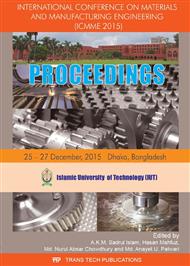p.123
p.129
p.134
p.140
p.146
p.152
p.158
p.165
p.173
Performance Analysis of Poly Vinyl Chloride Outsole Using FEA Method
Abstract:
This paper focused on the performance analysis of Poly vinyl chloride (PVC) outsole in order to improve the sustainability of the outsole design. According to footwear construction, outsole is the outermost layer which comes with direct contact with ground surface. A broad spectrum of materials are used in footwear construction as outsole but PVC is widely used which is manufactured from monomer named vinyl chloride. During wearing life cycle, footwear as well as the outsole has to pass through various mechanical operation, weather condition, ground surface friction and body weight pressure, hence the shape of the outsole may be distorted which may affect the foot. In order to consider these factors, several prototype outsoles required to test in biomechanics lab before mass production that is expensive and time consuming. Therefore, this study aimed to employ a finite element (FE) method to investigate the performance of PVC outsole by analyzing properties such as stress, thermal insulation behavior, factor of safety, fatigue check. A detailed 3D PVC FE model was created using Solid Works Software. The FE model calculation was compared to the physical measurements of a PVC outsole to validate the FE model. After the FE model validation, this study conducted different outsole properties analysis. This FE stress analysis reveals that the maximum stress was occurred in the heel breast portion. Therefore, material density should be given high in this portion to prevent crack development. The displacement analysis result reveals that in the forepart of the outsole, the maximum displacement occur which is 15.6748 mm and the thermal analysis result shows that there will be no crack develop in the outsole even at-20°C and the outsole was thermally stable up to-20°C.
Info:
Periodical:
Pages:
146-151
Citation:
Online since:
December 2016
Authors:
Price:
Сopyright:
© 2017 Trans Tech Publications Ltd. All Rights Reserved
Share:
Citation:


